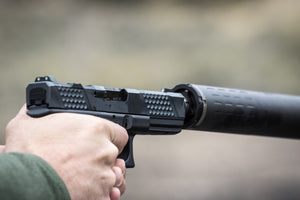Two popular mounts on gun muzzles are suppressors and compensators. While we can't deny that they both look cool, they each serve different purposes. This article is to give insights into what each of these devices does, why they are important, and how they differ from each other.
What are Suppressors?
You may remember them as silencers, cans, or mufflers. American inventor Hiram Percy Maxim developed gun suppressors in 1902. A suppressor is a gun attachment that reduces a gun's loud noises. They are sound moderators that function by adjusting the pressure and rate at which propellant gas leaves the muzzle.
Pros of Suppressors
- Protect both the user and people around from hearing damage
- Helps to reduce felt recoil from shooting and increase accuracy
- Prevents noise pollution
- Contributes to a reduction in muzzle flash
Cons of Suppressors
- Makes it more difficult to conceal handguns
- Adds to the weight and length of guns
- Can affect your point of impact
- Increases the heating of guns
- Difficult to clean
- Illegal in a lot of counties
What are Compensators?
While gun enthusiasts will hold you in contempt for the mixup, compensators are sometimes called muzzle brakes. Compensators are muzzle attachments that redirect the flow of propellant gasses to reduce recoil. Guns that have had compensators integrated into their muzzles are called ported guns.
Pros of Compensators
- Reduced muzzle rise and felt recoil
- Improved shot accuracy
- Faster follow-up shots
Cons of Compensators
- Increased noise production
- Difficult to properly equip
- Increases the weight of the gun
How Suppressors and Compensators Work
Both devices work by adjusting the way propellant gasses leave the muzzle. When you pull the trigger on a gun, an explosion is initiated. The force of this explosion forces the bullet out of the barrel at high speed and force. However, residual gasses from the explosion are also expelled at high pressure.
How Suppressors Work
Suppressors create room for the gasses to expand before it is released into the atmosphere. Suppressors have a larger volume than gun barrels and take advantage of the inverse relationship between pressure and volume of gasses.
The pressure and force the gasses are moving with are reduced as it passes through the suppressor, leaving it with less energy and, therefore, less noise.
The inner section of suppressors is divided into cylindrical compartments called baffles. As propellant gasses move with fired bullets, they move through and fill baffles, increasing their volume and reducing their pressure. When the gasses eventually make contact with the atmosphere, they would have lost significant energy, making much less noise.
How Compensators Work
On the other hand, compensators change the route the gasses pass as they leave the barrel. According to Sir Isaac Newton's work, we know that when a force is generated in one direction, a force with an equal magnitude is generated in the opposite direction. The opposing force generated when a gun is fired is called recoil.
Naturally, the shooter experiences a backward push in response whenever a gun is fired. Compensators "compensate" for these backward and upward pushes (recoil) by changing the direction the gasses are expelled.
Compensators have chambers and holes. It traps the gasses in the chambers and releases the gas through side holes to reduce the upward rise of the muzzle and stabilize the gun for subsequent shots.
Conclusion
In summary, Suppressors and compensators help you improve your aim, protect your ears, and help you pull off multiple shots in quick succession with greater accuracy.
The market for muzzle attachments has risen steadily from the early 2010s, with suppressor sales rising by 37% in 2013. It is vital to know the difference between the two and to understand exactly what you are getting from each.


